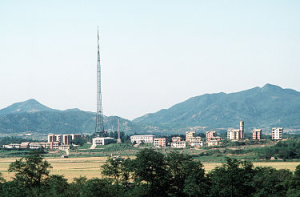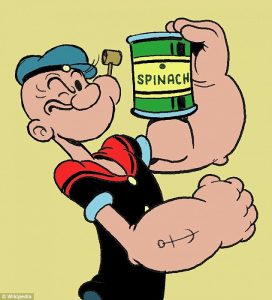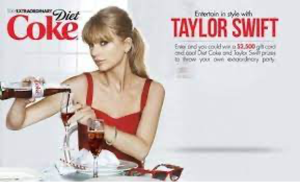Propaganda: The language of systemic influence
22 Examples and Case-Studies in Propaganda
Example One – Kijong-dong, North Korea (Nico)
While much of wartime propaganda is restricted to posters and brief broadcasts due to the everchanging, rapid nature of war, propaganda consists of much more. During the Korean War as the country split into the Communist North and Capitalist South, North Korea constructed a city that they reported had the following:
- 200-family collective farm
- Child care center
- Kindergarten/primary/secondary schools
- Hospital
- Multi-story concrete buildings
- Bright-blue roofs with white sides
This city was then spread during the Korean War as the North tried to call a larger number of Koreans to their side, hoping to turn the tides of the conflict. Reports of the city, as well as one picture (see below), began spreading across the country as the war continued.

However, upon closer inspection by South Korean intelligence, the town North Korea called “Peace Village” became known as “Propaganda Village” everywhere else in the world. Using telescopes and modern technology, the large buildings were revealed to have no glass in the windows and the lights were set to turn on and off automatically, so as to ensure the city look lively and inhabited. To further the illusion, sidewalks were periodically swept and the city cleaned by members of the North Korean government to maintain the illusion that Kijong-dong was full of life.
Microphones and loud speakers are also present in Kijong-dong directed southwards, as the North Korean government broadcasts their alleged values, beliefs and virtues at the South Korean population, in hopes of recruiting new people to the cause. In retaliation, the South began doing the exact same thing – shouting democratic and capitalist ideas to the North in hopes of alerting North Koreans that they have a choice in how they live. Thus despite the fact that both North and South Korea believe they are doing what is right, it can surely be viewed as propaganda regardless.
Example 2
Spinach, Science, and Superheroes: Debunking Myths and Celebrating Pop Culture’s Impact on Nutrition
The story of German scientist Erich von Wolf’s decimal point miscalculation with spinach’s iron level is popular. The story goes that von Wolf’s transcription error tenfold increased spinach’s iron content from 3.5 to 35 milligrams per 100-gram serving. This misconception led to the assumption that spinach is high in iron, making it a superfood and impacting pop culture, including Popeye’s power. However, certain versions may exaggerate the error’s significance or details. Although spinach is a good source of iron (and other minerals like vitamins A and C, calcium, and folic acid), some researchers challenge its exceptional iron concentration due to a decimal miscalculation. Over time, the myth has become a warning regarding scientific study and data collection quality. Spinach contains iron, but not as much as the myth says. Its iron level is comparable to other leafy greens, making it a healthy part of a balanced diet but not a magical iron supply. This anecdote illustrates how disinformation can permeate society. (Popova, 2015)
In reality, spinach farmers in the 1930s said that Popeye was responsible for rescuing their business and increasing demand for spinach by 33% in the United States. (King Features Syndicate, 2024)

This shows how cartoons can manipulate people in certain way by depicting something.
VB
How to gain public support during World War One, using Propaganda
The Committee on Public Information (CPI) is a good example of propaganda from World War I. This committee represents government-sponsored propaganda. The investigative journalist George Creel said, “weld the people of the United States into one white-hot mass instinct” (O’Toole, 2019), with a “war-will, the will to win” (O’Toole, 2019), thus showing that the government intended to unite the public by acting on their emotions by creating united and passionate support for the war through their widespread propaganda which was manipulating the public. This highlights the essence of propaganda: the deliberate and systematic attempt to shape perceptions, modify cognitions, and influence conduct to elicit a response that supports the propagandist’s desired outcome.
The CPI was also used for press releases that were disguised as news articles or patriotic commercials, but were really simply another kind of propaganda. These were well-thought-out operations that were meant to blend smoothly into the media ecosystem, enhancing the government’s narrative but avoiding the appearance of putting pressure on the people. It was intended to keep the sentiments at home high by showcasing and talking about the “good news” about going to war with strategic patriotic propaganda while omitting the more sombre complex information of the war difficulties. This selective presentation of material accentuated the advantages while leaving out many of the negatives, ensuring that support for the war remained strong and criticism was kept to a minimum.
Another darker form of propaganda was the distribution of posters depicting German soldiers in the form of apes holding what appeared to be bare-breasted American women in their arms, with slogans below that read, “Destroy this mad brute” (O’Toole, 2019), which combined to shift public opinion away from the opponent soldiers being humans, thus dehumanizing them. This picture was specifically designed to alter the emotional state of its customers, eliciting sentiments such as hatred and anger toward the Germans, which was exactly what this propaganda was supposed to achieve. Garner increased support for the fight and hatred for the enemy.

Reference
Destroy this mad brute photos and premium high res pictures—Getty images. (n.d.). Retrieved March 19, 2024, from https://www.gettyimages.ca/photos/destroy-this-mad-brute?assettype=image&alloweduse=availableforalluses&family=creative&phrase=destroy%20this%20mad%20brute&suppressfamilycorrection=true
How the us government used propaganda to sell americans on world war i. (2023, March 28). HISTORY. https://www.history.com/news/world-war-1-propaganda-woodrow-wilson-fake-news
King Features Syndicate. (2024, February 22). Popeye | Explore the history of Popeye. Timeline – History. https://popeye.com/history/
Popova, M. (2015, November 3). The True Science of Spinach and What the Popeye Mythology Teaches Us about How Error Spreads. The Marginalian. https://www.themarginalian.org/2013/07/02/spinach-popeye-error-half-life-of-facts/
Testimonial Propaganda

Testimonial Propaganda is a type of persuasion technique that uses endorsements from celebrities or social media influencers to promote a product, service, or cause, These types of advertisements can be seen as evidence of the credibility, quality, or effectiveness of whatever is being promoted. Most people see a celebrity or influencer that they are fans of promoting a product or service and choose to believe what they are saying, but testimonial propaganda can sometimes be manipulated or fabricated to serve a specific agenda.

Just think about your favorite YouTuber or TikTok influencer. Have they ever posted a video or photo of them raving about a skincare brand or an energy drink that keeps them going through the day? The public’s trust in these influencers runs deep, so when products are advertised, followers will jump on board. There are ethical considerations though when testimonials are used. False or misleading testimonials can trick consumers. While false advertising is illegal, there is nothing stopping a celebrity from lying and saying that the skin cream they use every day clears their acne, when in reality they were just born with clear skin.
The fact that a person cannot completely trust these types of advertisements demonstrates that they are an example of grey propaganda. Grey propaganda may or may not have an identifiable source, but the accuracy of the information is uncertain. Testimonial propaganda uses gray propaganda by having well known celebrities and influencers promote products and ensure trust in the advertisements. Fans of these celebrities and influencers believe the words that are being told to them, but the accuracy of this information is not always 100% true.

Feedback/Errata